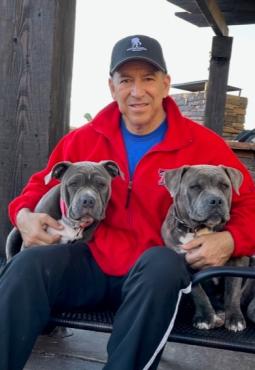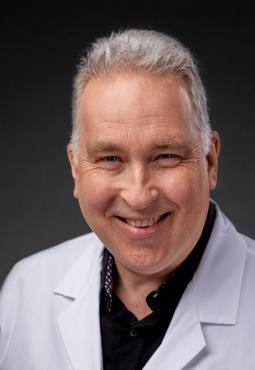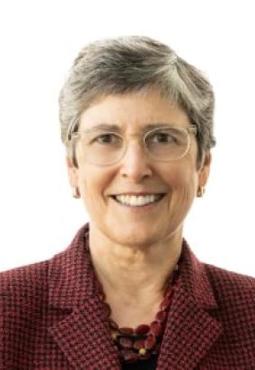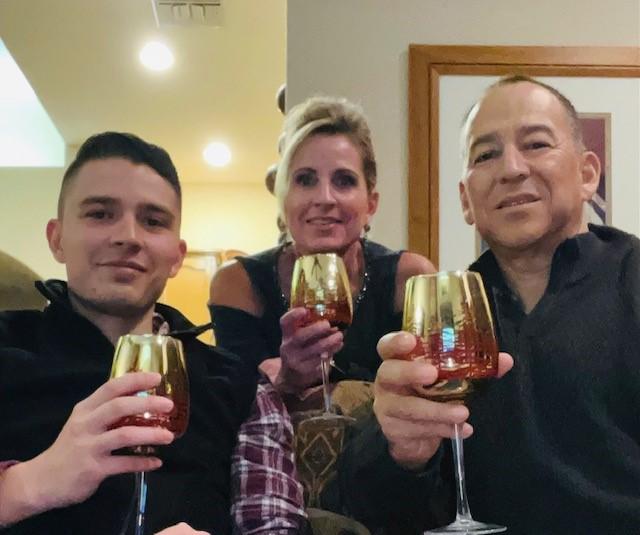“I thought I was Superman. I thought I had this big ‘S’ on my chest.”
At 61, Larry Brito thought he was invulnerable. For 27 years, this Texas farm boy turned Air Force Academy and Texas Tech alumnus served as an FBI special agent, going deep undercover to bust up cross-border black tar heroin cartels. His knowledge of the terrain, plus his bilingual skills, helped Brito excel, pulling down hundreds of arrests and earning a string of national awards.
The close calls never fazed him. Not even when he had to use aliases and multiple addresses to evade assassins determined to stop his testimony in a major case. He shrugged off the necessity of getting married in a secret location, where every guest was screened by the FBI and a heavily armed SWAT team stood guard.
He and wife Rhonda just marked their 30th anniversary, and she says it never bothered her either.
“I’m not that type. I’d never hold anyone back,” she said. “I always trusted that Larry was the best at his job, and that he was happy.”
It felt like a charmed life. Almost. But sometimes, the most dangerous enemy is within.
Blindsided
In 2010, Brito noticed some varicose veins and unusual bleeding. A bone marrow biopsy revealed the reason: a mild case of myelodysplastic syndrome (MDS), a rare blood disorder that can cause anemia, shortness of breath and infections — or can reside in the system for years with virtually no symptoms. Over time, the condition can worsen and, in some cases, it can lead to leukemia.
No one is sure what causes MDS, but his doctors think Brito’s fate may have taken shape when he was 6 or 7 years old, picking cotton, onions and watermelons on his father’s farm in Presidio, Texas (about 250 miles south of El Paso), getting exposed to chemical fertilizers under his feet and pesticides dumped from crop-dusters flying over his head. “That stuff burned when it hit your skin,” he remembered.

Brito’s early MDS symptoms were minor and manageable, and he kept working. By 2014, he had left the FBI and transitioned into equally challenging roles at the State Department and with private contractors that took him to Mexico, Afghanistan and the United Arab Emirates.
Then, the seizures came. Small ones at first, but they slowly intensified. Fatigue set in. He kept going. In late 2021, he thought he felt well enough to begin training for the Senior Iron Man Biathlon in El Paso.
“I ran two blocks, and I couldn’t breathe,” he recalled. “I thought it was COVID.”
It wasn’t.
After doing considerable research, the Britos headed for Cancer Treatment Centers of America (CTCA) in Phoenix, now known as City of Hope Phoenix. This was just before CTCA was acquired by City of Hope in early 2022, but the cross-pollination had been going on for quite some time: The first physician they met had a City of Hope connection going back decades.
“I’d worked with City of Hope back in 1997 to help develop their stem cell program,” said Jeffrey R. Schriber, M.D., director of hematologic malignancies for City of Hope Phoenix. Schriber had had long and productive relationships with City of Hope hematological experts, and it was now clear he was going to need them.

“Larry’s blood count was dropping, and I was concerned that his [low-level] MDS status had changed,” he said. In fact, Brito had become one of those extremely rare people whose MDS rapidly progressed to a severity of 9 out of 10. He was in trouble, and there was no time to waste.
“They told me that if we did nothing, I’d live maybe three weeks,” Brito said. “If we started chemotherapy, maybe I’ll have three months. If we add radiation, maybe six months.”
Suddenly, Superman had encountered kryptonite.
“I couldn’t sleep,” he remembered. “All I could think about was my family, not seeing them again. I felt I had no control, and I didn’t know what to do.”
His only hope, said Schriber, would be a stem cell transplant. But Schriber’s team in Phoenix did not yet have the staff and infrastructure to handle the procedure. (That is changing. City of Hope Phoenix is ramping up and will soon perform its first stem cell transplant on an MDS patient.)
Teamwork
So, Schriber picked up the phone and called an old friend: Eileen P. Smith, M.D., City of Hope’s Francis & Kathleen McNamara Distinguished Chair in Hematology & Hematopoietic Cell Transplantation.
In short order, the Britos were in Smith’s office on the Duarte, California, campus. One of the first things Smith did was jot down her cellphone number and hand it to the couple. “She said, ‘Call me anytime, any hour,’” Brito remembered. “I’ve never heard of any other doctor doing that.”
He was just as impressed by the atmosphere at City of Hope.
“They told me that my No. 1 priority was to believe I can get well and to get ready to fight,” he said. “I felt like I was in this first class place, and it felt really good.”
It would be a long fight, and they had to hurry to get started.

Normally, a search for a stem cell donor spans the globe to locate the best match, which often ends up being someone from overseas. Brito didn’t have that kind of time. Instead, his doctors chose Brito’s son Kyle, who turned out to be an acceptable “half,” or “haploid,” match.
“Kyle was nervous,” recalled Rhonda. “He hadn’t been in a hospital since he was 6 weeks old. But he said he would do it no matter what.”
“I’m glad it was me,” added Kyle, who works in the health care field as an administrator (younger brother Eric is an Air Force pilot). “We were all hands on deck.”
Although the transplant procedure itself is relatively quick, preparation and recovery can stretch into many months. The Britos essentially uprooted their Texas life; he was staying with friends in Santa Clarita, California, when not in the hospital, and she was dealing with “a leaky roof and two new puppies at home” while also doing the long-distance commute and taking daily COVID-19 tests so she could be with her husband while staying at a local hotel. It was a long ordeal.
“We did what we had to do,” she said.
On Christmas Eve 2021, following multiple sessions of chemo and radiation, Brito underwent the transplant. He decided to make his recovery rather eventful, determined not only to get up and walk around immediately after, but to set the campus record. “I walked 237 miles in six weeks!” he said proudly.
He set another record, too, becoming the first transplant patient to begin at the Phoenix facility (even before it became City of Hope), transition to the main campus for the procedure and then return to Phoenix for follow-up care, where he is once again under Schriber’s supervision. All agree the continuity of care has been seamless.
“No gaps,” said his wife. “The care has never wavered.”
“Any time you do a transition of care,” Schriber said, “that’s where there’s a danger that things get dropped. It’s so important that everyone communicate. That’s a critical thing, and City of Hope is very good at doing that.

“This is the model that we want to use for taking care of our patients.”
One year post-transplant, Schriber is proud of his patient.
“Larry’s doing fabulously. He’s hit the trifecta: No disease. No more graft-versus-host disease. And he’s off immunosuppressant drugs.”
Brito has his own measure of success: He’s training once again for the Senior Iron Man Biathlon, going considerably farther than two blocks this time.
“Now when I go to City of Hope for follow-up visits,” he smiled, “the staff says to me, ‘You got the ‘S’ back on your chest again!’”
